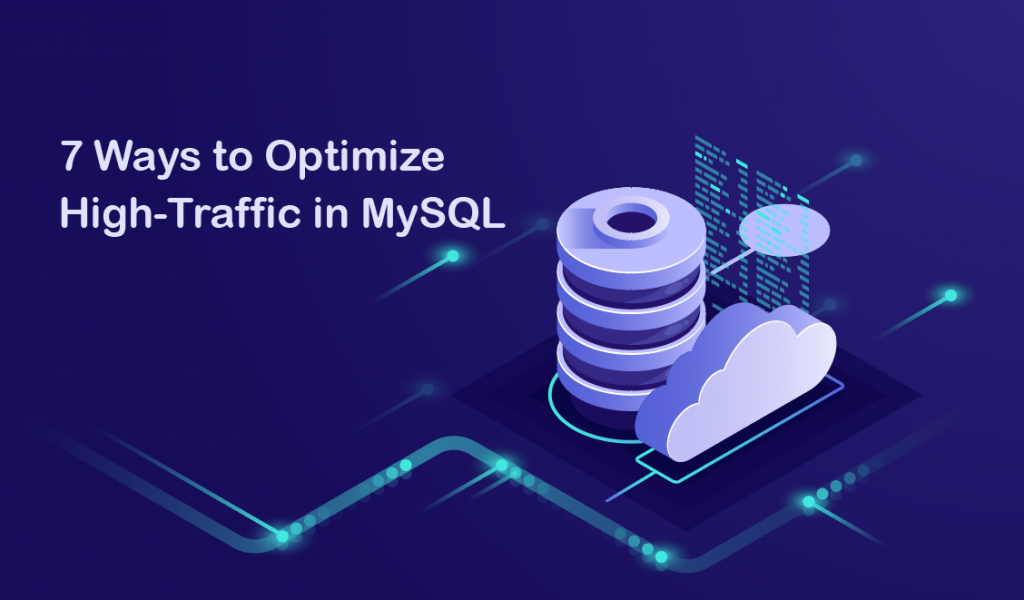No products in the cart.

You might face a sudden spike in your traffic in MySQL, and this can be due to many reasons. When the load in your system increase, you would experience a delay in response time, your database will be unavailable, etc, so make sure you mitigate these error as soon as possible. You can try any of these methods to optimize high traffic in MySQL.
Optimize high traffic in MySQL using these easy ways:
1) Scale your Cloud Instance Size
Going to a larger instance size in the cloud or any virtualized environment is often the easiest thing to do. It is a short-term step that you can take while implementing other performance optimization actions and it is one of the most expensive things.
Note: It is not necessary that if the cloud vendor has a large instance for about 10x, it can handle 10x traffic, so make sure, you don’t jump to such a conclusion.
2) Disabling Heavy Load Features
Optimize high traffic in MySQL using these easy ways
Management and development teams generally despise such concepts, yet they are an effective tool to have. Not all software features give the same value or use with the same frequency, but it is advanced, rarely used features are frequently the most expensive since they haven’t had much time to be optimized. Temporarily disable, while you deal with traffic spikes or find a time to improve them is often a good idea.
It does not have to be user-facing features; consider whether there are any internal-facing reports that you can do without?
3) Examine Background Task
Background activities such as backup, maintenance, report generation, and large data loads are frequently underutilized. They can run in a slower time when the MySQL Server can manage the additional load. They might cause database overload and download during traffic spikes.
Overlap or snowballing is another issue with background jobs running during traffic spike events. If your background task generally runs 15 minutes and you scheduled two of them at 2 & 3 a.m., one of them will usually operate at a time. However, due to the increasing load, it may now take two hours to complete and may have numerous background tasks running simultaneously, causing additional load and possible data corruption.
Analyze your background activity and ask the below questions:
- Is this background task needed, or can it be postponed?
- Is it possible to execute this job on a replica? Having a different job run on separate duplicates can be a good option!
- Have you planned your batch jobs to avoid overlapping?
- Is it possible to optimize a background task? Optimize the queries it uses, or if you are taking a backup with mysqldump, utilize Percona Xtrabackup, which is more efficient.
Can you minimize the resources used by this job? Limiting the concurrency (number of concurrent connections) that a process generally uses, for example. Alternatively, if you use Percona Xtrabackup and it affects your server performance, you may Throttle Backups.
4) Configuring Application Server
It is necessary to select the proper settings on your application server-side while configuring MySQL Server. If you’re using TLS/SSL for database connections, you should ensure that you’re using permanent connections rather than re-connecting for every limited transaction. When you’re using a connection pool, make sure it’s correctly configured and that you’re not using ProxySQL or Threadpoo. Recommendations will vary for specific performance optimization based on the programming language, Connection pool used, or ORM framework.
5) Configure MySQL Server Properly
Check if your MySQL server is configured properly, if not you need to fix that first. Fixing the basics will save you during heavy traffic and aid performance for your workload.
6) Complete Database Maintenance
You need to check your database statistics and ensure it’s not outdated. Check if the tables are in the optimal state. If not run the below command:
Run OPTIMIZE TABLE on your tables. This will re-build, become more efficient and update the stats.
To run OPTIMIZE for all tables. Use mysqlcheck –optimize -A.
Note: Make sure you don’t run this during a high load instead you can try removing the replicas one by one.
7) Deploying More MySQL Slaves/Replicas
Another way is based on the workload you have, whether it is ‘read intensive’ or ‘write intensive’ workload. If it’s read-intensive then you can deploy more replicas, which will improve the performance, and also check to see if your application can allow traffic to them.
Note: MySQL replication is asynchronous, route queries only replicate to date, so monitor for replication lag and health.
Hope this was helpful to optimize high traffic in MySQL. Identify which works for you; if not you can get assistance from our Database Administrator who can help you improve the performance.
To get updates follow us on Facebook, Twitter, LinkedIn


